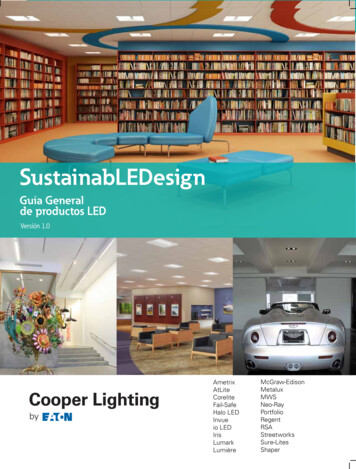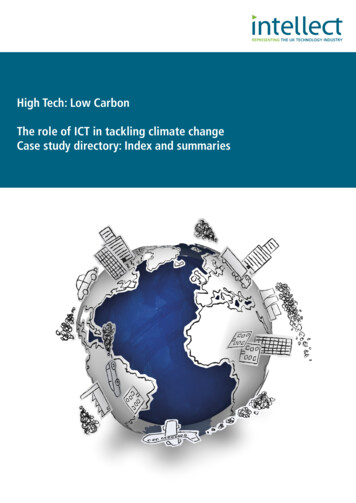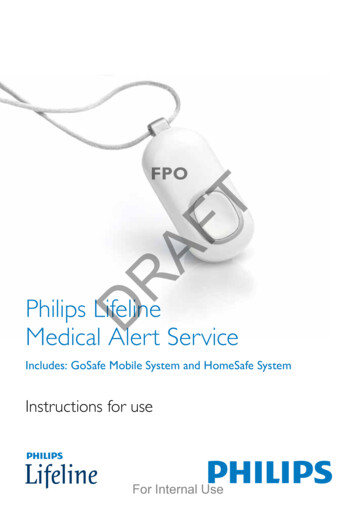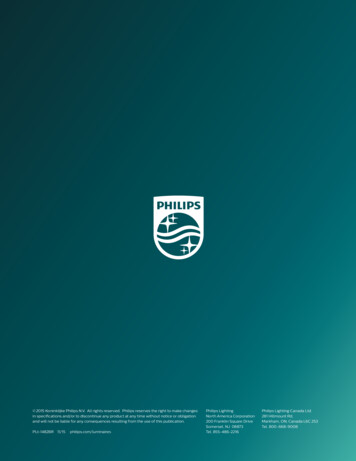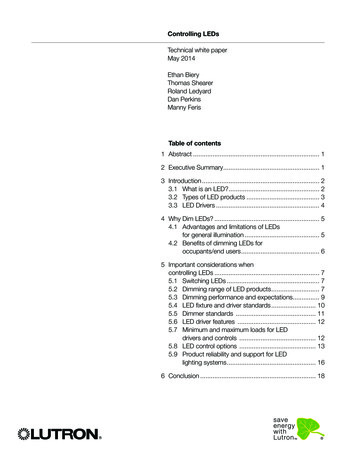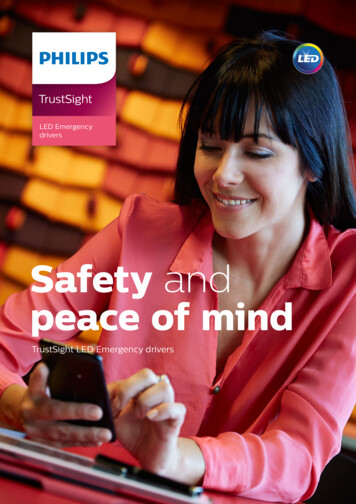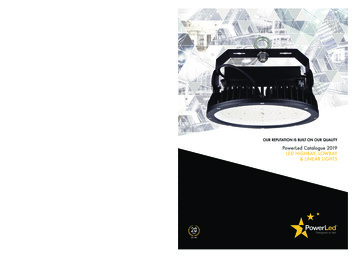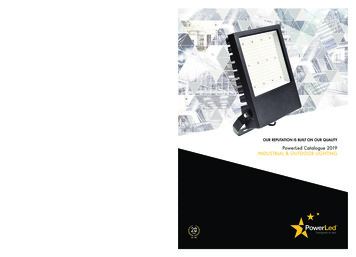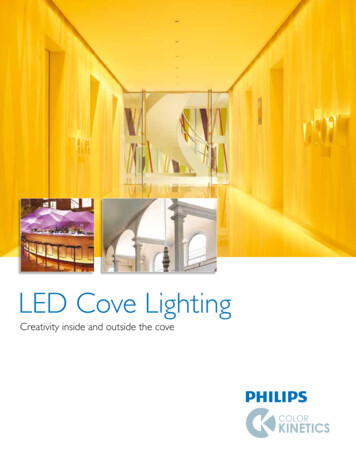
Transcription
LED Cove LightingCreativity inside and outside the cove
Photography: Richard PareCreativity inside andThe Cove series of linear LED lighting fixtures from Philips Color Kinetics is ideal for all traditional coveand indirect lighting applications. It also offers extraordinary flexibility for creating highly innovative andintricate lighting installations outside the cove. Our low-profile linear LED cove fixtures can producesolid white, solid color, intelligent white, or color-changing light at various levels of intensity and beamangles to support an astonishing array of traditional and unconventional applications.Traditional cove lighting is an indirect lighting technique in whichlinear lighting fixtures are connected end-to-end and concealedwithin a cove, soffit, or similar architectural structure. Covesare often positioned at the perimeter of a space, either near thetop of a wall to direct light upward onto the ceiling, or at theedge of a ceiling to direct light onto the top of the wall.From general illumination to spectacular, innovative lighting effectsSolid white LED cove lights from Philips Color Kinetics provide general illumination from traditional center-ceiling and perimeter coves in thedining room at Corton Restaurant in New York City, USA (above left). iColor Cove MX Powercore fixtures, installed behind frosted panels,produce a stunning interactive experience in the Target Interactive Breezeway atop Rockefeller Center in New York (top right).2LED Cove Lighting
Photography courtesy of Electrolandoutside the coveCoves in the center of the ceiling, curvilinear or roundcoves, vertical coves, and other special shapes andtypes of openings can create an extensive range ofeffects.For over 10 years, Philips Color Kinetics has enabledmillions of feet of cove installations around the world.Photography: Mikael SilkebergOutside the cove, LED cove lighting fixtures canproduce spectacular and innovative effects limitedonly by your imagination. The color-changing linearLED fixtures in our Cove series create dynamic andinteractive lighting experiences that simply cannot beachieved with conventional cove lights.PUB, Stockholm, SwedeniColor Cove MX Powercore, color-changing LED cove lights, illuminate thedome at PUB, Stockholm’s oldest department store. Lighting scenes changethroughout the day to vary the ambience of the space. (See also page 14.)LED Cove Lighting3
4LED Cove LightingPhotography: Christian Richter
Stunning, uniform lightfrom a coveIndirect lighting from a cove or other architectural feature plays a significant role in establishingthe mood or atmosphere of a room. When used effectively with other lighting techniques,cove lighting can heighten the sense of drama in a room or make a room feel brighter and morecheerful. Cove lighting can emphasize intriguing architectural detail such as unusual ceiling linesor coffered ceilings.Superior color consistency in linearcove applicationsAchieving consistency of light output in white-lightcove applications is one of the most difficult challengesfacing lighting designers. Light sources are positionedvery close to illuminated surfaces, so there is very littleroom for color mixing, and the appearance of the light isstrongly angle-dependent. Even small variations in colortemperature and hue are clearly visible.Linear fluorescent light sources are fairly uniform, butcove applications that use them can suffer from socketshadowing — areas of low luminance toward the ends ofthe fluorescent tubes — and hot spots, creating an unevendistribution of light along the illuminated surfaces.Linear LED cove lights pose their own challenges toconsistency and uniformity of light distribution. The beamproduced by an LED cove light is a series of adjacentpoint sources, each with some difference in hue and colortemperature. Unless these differences are tightly managed,unwanted variations in light output can result.With Optibin, our proprietary binning algorithm, PhilipsColor Kinetics LED cove lighting fixtures set newstandards for color consistency and uniformity across LEDsources, fixtures, and manufacturing runs. For white-lightapplications, we allow significantly smaller variations incolor temperature (CCT) and hue (Duv) than the limitsset by the ANSI chromaticity standard. This means thatcolor variations along linear runs are virtually invisible.Our LED cove lights also feature extremely high colorspatial uniformity (CSU), exceeding accepted industrystandards. There are no visible color variations acrossthe beam from center to edge, or at different viewingangles — an especially important consideration in angledependent cove lighting applications.The result is extremely uniform and consistent colorin linear cove applications, with no socket shadowing,hot spots, color shifting, tiger-striping, or unwantededge effects.World Market Center, Las Vegas, Nevada, USAWorld Market Center uses approximately 8,000 ft (2.4 km) of eW Cove Powercore, energy-efficient LEDcove lighting fixtures from Philips Color Kinetics, to illuminate the atrium of its Building C.Photography: Darius KuzmickasLED Cove Lighting5
Exactly the right levelof lightMany lighting design professionals recommend a layered approach to lightingdesign. The layers — ambient, task, focal, and decorative — each performa different function in the lighting of a space, often blending and reinforcingeach other.Cove lighting is part of the ambient layer, whichprovides the uniform, overall lighting for a space.The ambient light layer is critical for establishingthe atmosphere of a space.Lighting the walls from a cove or slot at theedge of the ceiling can make a room seem morespacious, warm, and intimate, while lightingthe ceiling from a cove at the top of a wall canmake the room seem cooler, quieter, and moreformal. The more even the lighting, the morerelaxed the room will feel.Adjusting the light level of the ambient layerrelative to the light level of the task layer canalso change the feeling of a space. If the ambientlight level is significantly lower than task lightlevels, the space will appear more dramatic. Ifthe task and ambient light levels are nearly thesame, a space will seem brighter, more cheerful,and more calming.In white-light applications, ambient or covelighting often provides sufficient illumination forcreating a comfortable visual environment andfor moving around in a space. If the light levelof the ambient layer is high enough, however —above 30 fc or 300 lx — it can provide sufficientillumination for many general tasks, such asseeing into cabinets and drawers, casual reading,shaving, and business.Soild white (eW), solid color (eColor),intelligent white (iW), and color-changing(iColor) LED cove lights from Philips ColorKinetics are available at different levels ofintensity for a wide range of ambient lightingneeds.King Boulevard aboard the Carnival Valor6LED Cove Lighting
LED Cove Lighting7
8The owners of Boston-based Rustic Kitchen Bistro & Loungewanted warm, attractive lighting to properly accentuate thealcoves within the Biltmore-inspired ceiling of the restaurant’sTuscan Room (facing page). Neon and fluorescent light sourcesdid not offer the desired color temperatures, and the ownerswanted to avoid frequent lamp replacements in the dining room.a cool 6500 K. Unlike conventional light sources, the fixturesmaintain their precise color temperature even when dimmed.Now the staff can set the precise shade of white light that theydesire at the touch of a button — a cooler color temperatureduring the day, for example, and a warmer color temperature inthe evening.Because they offer a wide range of color temperatures,long useful source life, and zero-maintenance operation, therestaurant owners chose iW Cove Powercore fixtures, whichprovide controllable white light ranging from a warm 2700 K toOn this page, runs of eW Cove Powercore LED fixturesilluminate the guest tables and contribute to the complex lightingscheme in Rustic Kitchen’s Broadcast Kitchen Studio at MoheganSun Pocono Downs, in Pennsylvania.LED Cove Lighting
WarmCoolWhiteYour WhiteIntelligent white (iW) cove lightingfixtures from Philips Color Kineticscombine channels of cool, neutral, andwarm white LEDs to offer a range ofcolor temperatures that you can adjustwith a simple wall-mounted device.With these intelligent, dimmable,digitally controllable cove lights, you canselect the precise shade and intensity ofwhite light that you need.By adjusting the color temperature ofintelligent white cove lighting fixtures, fromwarm (more yellow / red) to cool (more blue),you can instantly alter the emotional effect ofa space, and dramatically affect the appearanceof objects on display in stores, galleries, andmuseums. By selecting the appropriate colortemperature of your light sources for yourenvironment, you can create the atmosphereyou desire, positively influence buyer behavior,and increase productivity in the workplace.Because LED light sources do not color-shiftwhen dimmed, you can vary the brightness ofyour cove lighting fixtures while maintaining aconsistent color temperature.Rustic Kitchen Bistro & Lounge, Boston,Massachusetts, USA (above) and PoconoDowns, Wilkes-Barre, Pennsylvania, USA(opposite)Photography: John Brandon Miller (above), Tom Bomer (opposite)LED Cove Lighting9
Consistently elegantWorld Market Center in Las Vegas, Nevada, USA (hereand on page 4) uses approximately 16,000 linear feet(4.8 km) of cove lighting fixtures to illuminatethe atrium of its Building C. Over 8,000 feet(2.4 km) of eW Cove Powercore whitelight LED cove fixtures, installed inthe atrium ceiling and elsewhere,blend seamlessly withconventional 3000 KT8 fluorescent covefixtures.10LED Cove Lighting
Photography:LED CoveDariusLightingKuzmickas 11
12LED Cove Lighting
Phoenix Children’s Hospital, Phoenix, Arizona, USAEnergy-efficient iColor Cove MX Powercore linear LED lighting fixtures in threelevels of coves integrate with other LED and conventional lighting fixtures tocreate an ever-changing and engaging environment for the lobby of the 600-bedPhoenix Children’s Hospital (above and opposite).Energy-efficient light,exactly where you want itBecause their light sources are inherently directional, LED cove lights excel at angle-dependent lightingapplications. They are far more efficient at delivering illumination to target areas than conventionalincandescent or fluorescent lamps.Conventional lamps radiate light in all directions,including toward the back of the cove, where the lightis wasted. Because LED cove lights direct all of theirlight output into a tightly defined beam angle, they wastefar less light. They can deliver equivalent or superiorilluminance to a wall or ceiling even when their totallumen output is lower than the total lumen output ofcomparable conventional luminaires.LED cove lights from Philips Color Kinetics offerenvironmentally conscious buyers green, energy-efficientlighting solutions without sacrificing quality or quantityof light. With its long useful source life, low energyconsumption, and virtually maintenance-free operation,eW Cove MX Powercore fixtures offer total costcomparable to dimmable T5HO and 2-lamp T8 strip lightsin cove and accent lighting applications.For white-light applications, linear LED lighting solutionsachieve high levels of efficacy, in some cases exceeding50 lumens per watt (lm / W) — sufficient to earn theENERGY STAR label, the government-backed symbol forenergy-efficient products in the US.The affordable eW Cove QLX Powercore can produceup to 272 lumens, replacing comparable T8 and T12fluorescent sources with a three-year payback,and comparable halogen and xenon sources with aone-year payback.Photography: Blake MarvinLED Cove Lighting13
Versatile in virtuallyinstallation anysituationSolid white (eW) and solid color (eColor) LEDcove lights from Philips Color Kinetics can beinstalled in narrow or tight architectural featureswhere fluorescent lighting systems requiringballasts, external power supplies, and otherelectronic components cannot.Patented Powercore technology rapidly, efficiently, andaccurately controls power output to fixtures directly fromline voltage, simplifying installation, eliminating the need forexternal power supplies, and allowing long runs of fixtureson a single circuit — over 100 fixtures per circuit in manyconfigurations.With flexible end-to-end locking power connectors, youcan position compact LED cove lights from Philips ColorKinetics even in challenging mounting circumstances, suchas in domes, curved soffits, and other unusually shapedcoves.Photography: Mikael SilkebergWhen connected end to end, LED cove lights from PhilipsColor Kinetics produce extremely uniform light withno socket shadowing, tiger-striping, or unsightly edgeeffects. Jumper cables specifically designed for each fixturein the Cove line can add extra space between units toaccommodate nearly any layout.14LED Cove LightingPUB, Stockholm, Sweden
Any cove, any situationTop: eW cove lightsilluminate the catwalk atghd, Leeds, UK.Center: Intense colorfrom coves at the topand bottom of the wallsin Valspar Corporation’smain office in Chicago,Illinois, USA.Bottom: eW CovePowercore fixturesfill the interior of OldNorth Church, Boston,Massachusetts, USA, withuniform white light.Photography: Chris Gascoigne (top), Craig Dugan Photography (center),John Brandon Miller (bottom)LED Cove Lighting15
Manhattan’s W New York luxury hotel offers guests a respite fromthe hectic pace of Manhattan life. In 2009, the hotel performedrenovations to transform its guest rooms, spa suites, andsophisticated Wow suites into relaxing, private sanctuaries.To enhance the soothing, nature-inspired décor, New York-basedarchitectural lighting designers G2J Design concealed over 3,000linear feet (914.4 m) of low-profile eW Cove Powercore 2800 Kwhite-light LED fixtures throughout the suites.In the double-height suites, the designers concealed eW CovePowercore fixtures behind the partition and wall art panels.During the day, the panels appear as art objects, while at nightthey become light boxes that softly illuminate the space. Thedesigners also concealed eW Cove Powercore fixtures abovethe bed canopies, within the graphic acrylic art panels above theheadboards, above the minibar to provide task lighting, and withinthe window pockets to highlight the curtains and fill the room withsoft ambient light. eColor Cove Powercore fixtures add dramaticsplashes of color above the minibar.Photography: Frederick Charles16LED Cove Lighting
Photography courtesy of ElectrolandThink outside the coveCove lighting fixtures from Philips Color Kinetics may be cove in name and form factor, but they’re much more thantraditional cove lights. Our high-output, precisely controllable, versatile, linear LED lighting fixtures enable ingenious accentand direct-view lighting applications both inside and outside the cove.LED lighting has revolutionized the way wethink about light, and the way we deploy lightsources to illuminate our spaces. It’s importantto think of LED lighting fixtures as more thansimply solid-state replacements for conventional lighting fixturesand systems.offer color-changing light digitally controllable in fine incrementsfor producing dynamic effects, creating interactive environments,and displaying large-scale video. Intelligent white LED cove lights offera range of color temperatures with which you can instantly vary theatmosphere of a room or enhance the appearance of objectson display.Intelligent white and color-changing LED cove lights from Philips ColorKinetics offer options for creatively illuminating a space that go farbeyond conventional lighting systems. Solid-color LED cove lights candramatically illuminate spaces as diverse as restaurants, nightclubs,spas, retail stores, showrooms, and domes. Full-color LED cove lightsBecause of their energy-efficiency, minimal maintenance requirements,long useful source life, and cool beam of light, LED cove lights fromPhilips Color Kinetics can be integrated directly into furniture,artwork, and architectural features where conventional lightingfixtures cannot.LED Cove Lighting17
18LED Cove Lighting
Limitless possibilitiesColor-changing iColor Cove MX Powercore linear LEDlighting fixtures are mounted within a Möbius-strip-likesculpture sheathed in glass beads at the Miracle MileShopping Center in Las Vegas, Nevada, USA. Becauseof their low profile and cool beam of light, LED lightingfixtures from Philips Color Kinetics can be incorporatedinto decorative and architectural structures for effectsthat go far beyond those achievable with conventionallighting systems.LED Cove Lighting19
Planning successfulcove applicationsPlanning a successful cove application involves a number of related considerations. To begin with,you must identify what type of effect you want to produce, then select fixtures that providesufficient light levels and distribution. In retrofit applications, you must make sure that your covefixtures offer form factors and operating temperature ranges appropriate for existing coves orsoffits. In new installations, you must design and build coves with the appropriate finish, horizontaland vertical clearance, and openings.Once fixtures and cove dimensions have been determined,you must place fixtures properly within the coves andaim them to achieve seamless color mixing and blending.If you’re using color-changing or intelligent white covefixtures, you must identify the number and locations ofpower supplies, controllers, and other required systemcomponents. If you’re using solid colored or solid whitelight fixtures, you must select and install switches orcompatible dimmers.20LED Cove LightingThe sections that follow offer rules of thumb and generalguidelines for planning and installing successful coveapplications using Philips Color Kinetics cove lightingsolutions. However, keep in mind that many factorscan affect the performance of cove lights in real-worldapplications, including ceiling height and the relative levelsof other light sources in the space. Therefore, we stronglyrecommend creating dimensional models, mockups, orcomputer renderings prior to installation.
Common cove designsCeiling illumination from perimeter coveat top of wallRustic Kitchen, Boston, Massachusetts, USACeiling illumination from a center coveLacoste, USAWall illumination from perimeter coveat edge of ceilingLassen Residence, Kapalua, Hawai‘i, USARadius applicationPhotography: John Brandon Miller (top), courtesy of LACOSTE (center top), StevenCordrey (center bottom), courtesy of Dublin Airport Authority (bottom)Dublin Airport, Dublin, IrelandLED Cove Lighting21
Selecting the right fixturefor your applicationPhilips Color Kinetics offers an extensive line of LED cove lighting fixtures to supportvirtually any conventional indirect or decorative lighting application for a cove. Choose thetype of light you want — color-changing, intelligent white, solid color, or solid white — thenchoose the beam angle and level of light output to achieve the desired lighting effect.When evaluating LED cove lights againstconventional cove lights, keep in mind that you mustdiscount the total lumen output of fluorescent orincandescent lamps by the fixture’s efficiency.For instance, a high-performance fluorescent covelighting fixture reports 860 lumens for the two T2lamps used within the fixture. However, the fixture’sefficiency is 66.9%, which means the fixture outputsonly 575 total lumens (66.9% of 860 575 lumensout, with 285lumens wasted).MXLumensQLXECPrice22LED Cove LightingThe efficiency ofintegrated LEDlighting fixtures,on the other hand,is always 100%,since the LEDsources (lamps)are integrated into the fixture, and the entiresystem is tested as a unit. In terms of fixture lumenoutput, then, eW Cove MX Powercore produceslumens per foot equivalent to the T2 fluorescentfixtures.Illuminance, which measures how much light afixture delivers to a target area at a certain distance,is often a better index of the performance of a lightfixture in a given application. This is especially truefor cove and other indirect lighting applications,where the amount of light emitted from the cove,the angle of incidence, and the fixtures’ throw has asignificant impact on the resulting effect.See page 24 for summary specifications on all PhilipsColor Kinetics LED cove lights, including lumenoutput and illuminance values at various distances.
Philips Color Kinetics LED cove lights at a glanceCove MX RGBCove QLX RGBCove EC RGBColor-Changing (iColor)iColor Cove MX PowercoreiColor Cove QLXiColor Cove ECBeam Angle125 x 120 100 x 40 / 120 x 120 120 x 120 Light Output387 lumens39 – 50 lumens11 lumens—— 2700 K – 6500 KIntelligent White (iW)iW Cove MX PowercoreBeam Angle110 x 110 Light Output656 lumensEfficacy (lm / W)37.3Color Rendering Index (CRI)82 Red Blue Green Amber Red Blue Green Amber Blue AmberSolid Color (eColor)Beam AngleeColor Cove MX PowercoreeColor Cove QLX PowercoreeColor Cove EC Powercore110 x 110 110 x 110 110 x 110 2700 K 3500 K 3000 K 4000 K 2700 K 3500 K 3000 K 4000 K 2700 K 4000 KSolid White (eW)eW Cove MX PowercoreeW Cove QLX PowercoreeW Cove EC PowercoreBeam Angle110 x 110 110 x 110 110 x 110 Light Output537 – 630 lumens232 – 272 lumens140 – 172 lumens43.9 – 53.142.5 – 48.745.0 – 56.981 – 8482 – 8582 – 83Efficacy (lm / W)Color Rendering Index (CRI)LED Cove Lighting23
Minimumcove height11.5 in (292 mm)mumstandoff29 mm)iColor Cove QLX120 x 120 beam angle, 180 rotationiColor Cove QLX100 x 40 beam angle, 180 rotationMinimumcoveheight7.5 in(191 mm)Minimumcoveheight2.75 in(70 mm)Minimumcoveheight2 in(51 mm)Determining cove dimensionsMinimumfixture standoffMinimum 1.375 in (35 mm)fixture standoff8 in (203 mm)For consistent results, theeW Cove QLX Powercore110 beam angle, 180 rotationMinimumfixture standoff7 in (178 mm)Minimumfixture standoff1.875 in (48 mm)Minimumcove height11.5 in (292 mm)iColor Cove MX Powercore125 beam angleeW Cove EC Powercore110 beam angle, 180 rotationcove width and height shouldiColor Cove QLX120 x 120 beam angle, 180 rotationMinimumcove height2.75 in (70 mm)accommodate a fixture’sMinimumcoveheight7.5 in(191 mm)Minimumcoveheight2.75 in(70 mm)minimum mixing distances, andMinimumfixture standoff2.125 in (54 mm)can vary greatly depending onMinimumfixture standoff1.875 in (48 mm)fixture output. The diagramsMinimumfixture standoff7 in (178 mm)Minimumcove height11.5 in (292 mm)to the right show example minimum cove dimensionsfor eW Cove EC Powercore and iColor Cove MXPowercore. Specific dimensions and positioningdepend on the details of your installation.Minimumfixture standoff12 in (305 mm)All dimensions given assume that coves and illuminatedsurfaces11010090have a matte white finish. Matte white is recommended, as itcan increase reflectivity in the cove by as much as 20%, diminishdiscoloration in white light applications, and increase overallsystem 0The table below lists illuminance values for various distancesin footcandles (fc), as measured during photometric testing byindependent, third-party testing labs. (For lux, multiply the fc valuesby 10.) You can use these figures as a general indication of thecove70 capability605040 of30our20 LED1010 20 lights3040 at50different6070 distances.8090100110Summary Specifications for Philips Color Kinetics LED Cove LightsMinimum Cove DimensionsIlluminance (fc*)0.5 ft15 cm1.0 ft30 cm1.5 ft46 cm2.0 ft61 cm2.5 ft76 cm3.0 ft91 cm45811551291813HeightStandoff21.5 in (546 mm)12 in (305 mm)FixtureColor / CCTBeam AngleLumens / FtiColor Cove MX PowercoreRGB125 x 120 387RGB100 x 40 39 – 429925118432 in (51 mm)1.375 in (35 mm)RGB120 x 120 46 – 50701884322.75 in (70 mm)1.875 in (48 mm)iColor Cove ECRGB120 x 120 111342.9.6.42 in (51 mm)1.75 in (44 mm)iW Cove MX Powercore2700 K – 6500 K110 x 110 65694023510459382611.5 in (292 mm)8 in (203 mm)4000 K100 x 100 6329522381066038269.5 in (241 mm)9 in (229 mm)3500 K100 x 100 576864216965435249.5 in (241 mm)9 in (229 mm)3000 K100 x 100 534804201895032229.5 in (241 mm)9 in (229 mm)2700 K100 x 100 527804201895032229.5 in (241 mm)9 in (229 mm)4000 K110 x 110 27234987392214107.5 in (191 mm)7 in (178 mm)3500 K110 x 110 2353067734191297.5 in (191 mm)7 in (178 mm)3000 K110 x 110 2423127835191297.5 in (191 mm)7 in (178 mm)2700 K110 x 110 2322967433191287.5 in (191 mm)7 in (178 mm)4000 K110 x 110 172216542414962.75 in (70 mm)2.125 in (54 mm)2700 K110 x 110 140180452011752.75 in (70 mm)2.125 in (54 mm)iColor Cove QLXeW Cove MX PowercoreeW Cove QLX PowercoreeW Cove EC Powercore* For lux, multiply fc by 1024LED Cove Lighting
Positioning fixtures in covesCoves should be wide enough so that youcan position the fixture to achieve thedesired lighting effect. Fixture standoff(distance from the back of the cove),fixture setback (distance from the coveopening), and fixture aiming (angle ofFor maximum light output, position fixtures closeto the line of sightincidence of light onto the illuminatedsurface) are all critical for ensuring thedesired intensity and uniformity of lightinside and out of the cove.Minimum fixture standoff is an especially importantconsideration, and one that is often overlooked.Even though linear LED lighting fixtures directa high proportion of their light output out ofthe cove, the back of the cove receives a certainamount of light, usually due to a combinationof fixture aiming, reflected light, and spill light.Because linear LED lighting fixtures emit light asa series of point sources, positioning the fixturetoo close to the back wall of the cove can resultin unwanted hot spots and shadowing. On theother hand, positioning the fixture too close to thecove fascia can trap the majority of a fixture’s lightoutput within the cove.For coves less than 9 ft (2.7 m) from the floor, determine the line of sightby drawing a horizontal line from the top edge of the cove fascia to the back ofthe cove.Cove lighting applications are especially sensitive tothe joints between light sources. When connectedend-to-end and positioned and aimed properly,Philips Color Kinetics LED cove lights produceuniform, consistent light with no socket shadowingor hot spots.Because of end-of-run effects typical of all linearlighting fixtures, minimum mixing distance increasesat the ends of runs of multiple fixtures, or whensingle fixtures are used in isolation. Extra careshould be taken to avoid or conceal unwantedcolor flares or variations in such situations. We alsorecommend stopping coves short of end walls toprevent sharp cutoff lines.For coves more than 9 ft (2.7 m) from the floor, find the farthest pointfrom which the cove is visible at a height of 7 ft (2.1 m), and draw a line fromthat point through the top edge of the cove fascia to the back of the cove.LED Cove Lighting25
Aiming fixturesNext to proper fixture positioning within the cove, fixtureaiming has the greatest impact on the amount of light out ofthe cove and the resulting effect.Most LED cove lights from Philips Color Kinetics have housings that canrotate through 170 or 180 in increments of 10 .eW Cove MX Powercore – 4000 K, 100 x 100 beam angle0 ft / 0 m1 ft / 0.3 m108 fc2 ft / 0.6 m68 fc3 ft / 0.9 m37 fc4 ft / 1.2 m5 ft / 1.5 m20 fc12 fc1 fc at 15.4 ft (4.7 m)9.5 in241 mmFor lux, multiply fc by 10As the diagram above shows, properly aiming fixtures let you achievedramatic and unusual effects from coves. Here, eW Cove MX Powercorefixtures are rotated in such a way as to create a grazing effect on theceiling, throwing bright white light to a distance of over 5 ft (1.5 m)toward the center of the room from a perimeter cove.Private Spa, Limerick, IrelandIn the words of the 2009 IALD Award ofExcellence press release, the design concept forthe Limerick House Spa was “to create a seriesof calming, coherent and relaxing spaces in anewly carved-out basement.”Photography Christian RichterThe pool is halo-lit from the perimeter byconcealed iColor Cove MX Powercore fixturesthat bounce light down the walls and definethe ceiling profile with a distinct line of light,providing a warm white glow or dramaticcolors. The IALD judges called the project “anarchetypal achievement for pool and spa lightingdesign.”26LED Cove Lighting
Reducing costs with LED cove lighting systemsLED cove lighting systems offer a cost-effective alternative to conventional incandescent and fluorescent systems.Although the initial fixture cost may be higher, LED-based lighting systems can offer a significant reduction intotal cost of ownership (TCO) over traditional systems by reducing the “cost of light.”Total cost of ownership (TCO) is essentially the total cost tothe owner of buying, installing, maintaining, and operating alighting system over the total useful life of the product. LEDlighting systems offer reduced TCO as the result of a decreasein the cost of energy consumed, as well as a significant decreasein maintenance expenses throughout the system’s useful life.Maintenance expenses include both the cost of lamps and thelabor required to replace them. In addition, decreased heatgeneration means less heat load and lower air conditioning costs.Also be sure to account for any costs related to compliancewith local or national regulations, and factor in rebates or otheravailable economic incentives for installing energy-efficientlighting systems in your region.When performing TCO comparisons, make sure you account forall factors that have an appreciable effect on initial, installation,configuration, maintenance, and energy costs. For instance, initialcosts include the cost not only of lamps and fixtures but alsothe cost of required accessories such as cabling, ballasts, andpower supplies, as well as the cost of control, including switches,dimmers, and digital controllers. Configu
Nov 25, 2016 · Photography: Darius Kuzmickas. 6 LED Cove Lighting Many lighting design professionals recommend a layered approach to lighting design. The layers — ambient, task, fo
